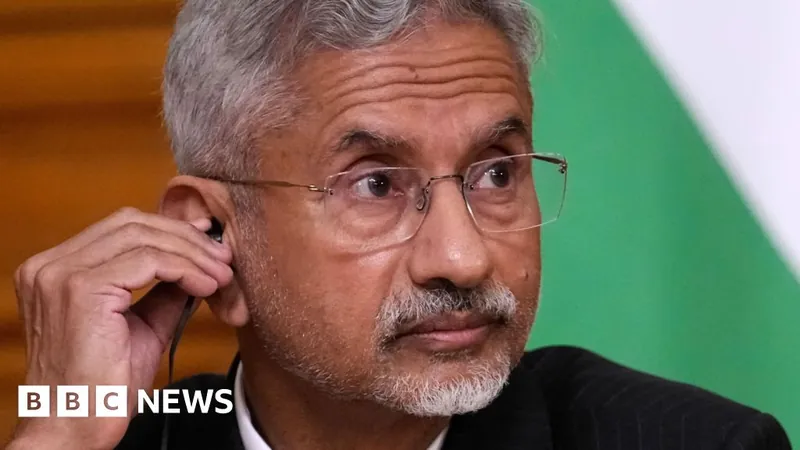
Estonia's Opioid Crisis: A Dire Warning for Britain
2025-09-21
Author: Charlotte
In a quiet suburb of Tallinn, Rasmus—a high-functioning opioid addict—administers a potent new drug that has turned Estonia’s drug scene upside down. What was once a struggle with accessibility has escalated into a crisis, with nitazenes, synthetic opioids far deadlier than fentanyl, emerging as the country’s main threat.
The Changing Face of Addiction
Rasmus, in his 30s, reflects on the shift from fentanyl to nitazenes in Estonia's drug supply, attributing his current struggles to the various additives that come with the new substance. "In 2019 I could hit myself blindfolded," he recalls, contrasting it with the surgical precision required now. Once a curious adolescent experimenting with substances, Rasmus's inquiries led him into the depths of opioid addiction, which initially seemed a reprieve from severe anxiety and depression.
A Brewing Storm
Starting full force in 2022, nitazenes have wreaked havoc, responsible for a staggering 56 drug-related deaths in Estonia that year alone. This alarming trend marks Estonia as the epicenter of Europe’s imminent opioid crisis, with neighboring countries potentially following suit. The statistics reveal that the country has led the EU in opioid mortality rates, shining a spotlight on a developing disaster.
Lessons from Estonia
Estonia's ordeal is more than a law enforcement battle; it’s a saga of social disparity and marginalization post-Soviet Union. Despite economic growth, the scars of unequal progress linger, particularly in communities like Lasnamäe where the Russian-speaking population faces significant socio-economic challenges. Rasmus's story is emblematic of a wider pattern, where addiction doesn't just arise from drug supply but also from entrenched social issues.
A Tale of Two Communities
Today, two distinct cultures of drug use are battling for dominance: older users in the Russian-speaking community rely on traditional street networks, while a younger cohort turns to online sources for pills. This duality exemplifies how the opioid epidemic has woven itself into the fabric of Estonian society, with devastating effects.
Dark Predictions Ahead
Experts like Artur Kamnerov warn of dire future consequences if nitazenes proliferate internationally as they have in Estonia. With users increasingly turning to new synthetic opioids, the cycle of addiction appears dauntingly cyclical. Accessible online drug markets represent a growing threat, making it easier than ever for users to acquire potent substances.
A Struggle for Support and Change
Harm reduction programs like MTÜ Convictus provide critical lifelines for users but are at risk of budget cuts due to a lack of public understanding. As societal perceptions fail to recognize addiction as a public health issue rather than merely a criminal one, the space for treatment dwindles. Activists like Mart Kalvet advocate for regulated drug supplies and social integration as essential steps toward breaking this cycle of addiction.
A Blemished Future
After multiple attempts to seek help, Rasmus faces insurmountable challenges due to soaring treatment costs. His poignant acknowledgment of a bleak future encapsulates the reality many addicts face. As Europe grapples with the implications of Estonia’s crisis, the greater societal stakes remain painfully evident.
A Wake-Up Call for the West
As drug markets spread across the UK and beyond, the repercussions of Estonia's crisis can serve as both a warning and a prompt for necessary change in drug policy. Addressing the societal factors driving addiction must take precedence, or the cycle of suffering will only continue, with far-reaching consequences.









 Brasil (PT)
Brasil (PT)
 Canada (EN)
Canada (EN)
 Chile (ES)
Chile (ES)
 Česko (CS)
Česko (CS)
 대한민국 (KO)
대한민국 (KO)
 España (ES)
España (ES)
 France (FR)
France (FR)
 Hong Kong (EN)
Hong Kong (EN)
 Italia (IT)
Italia (IT)
 日本 (JA)
日本 (JA)
 Magyarország (HU)
Magyarország (HU)
 Norge (NO)
Norge (NO)
 Polska (PL)
Polska (PL)
 Schweiz (DE)
Schweiz (DE)
 Singapore (EN)
Singapore (EN)
 Sverige (SV)
Sverige (SV)
 Suomi (FI)
Suomi (FI)
 Türkiye (TR)
Türkiye (TR)
 الإمارات العربية المتحدة (AR)
الإمارات العربية المتحدة (AR)